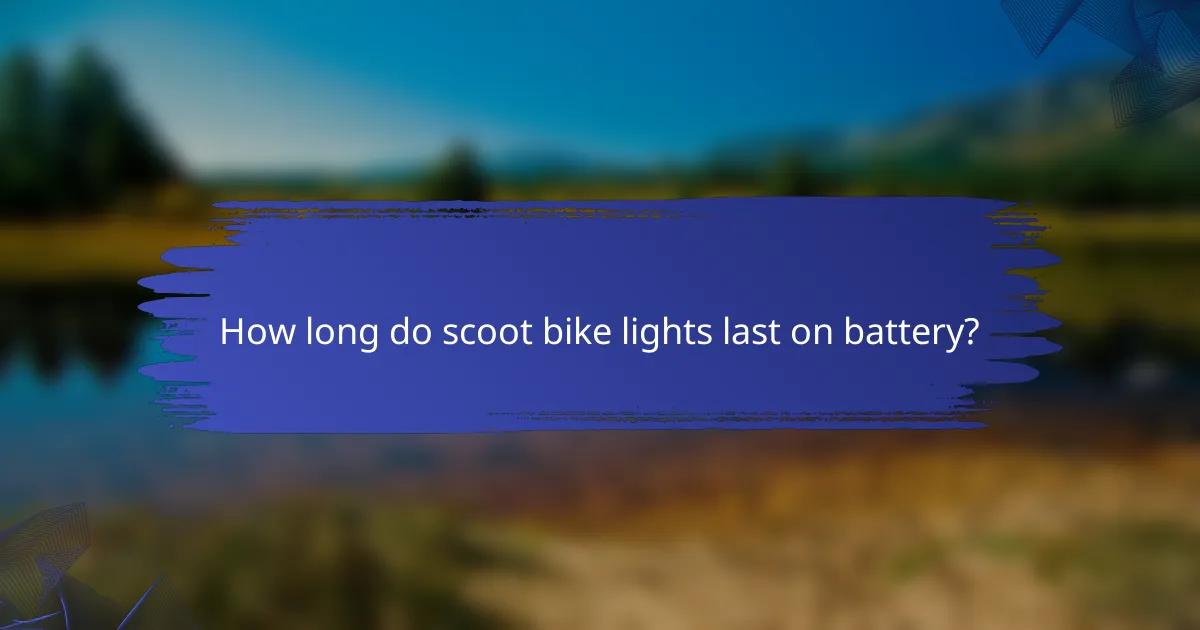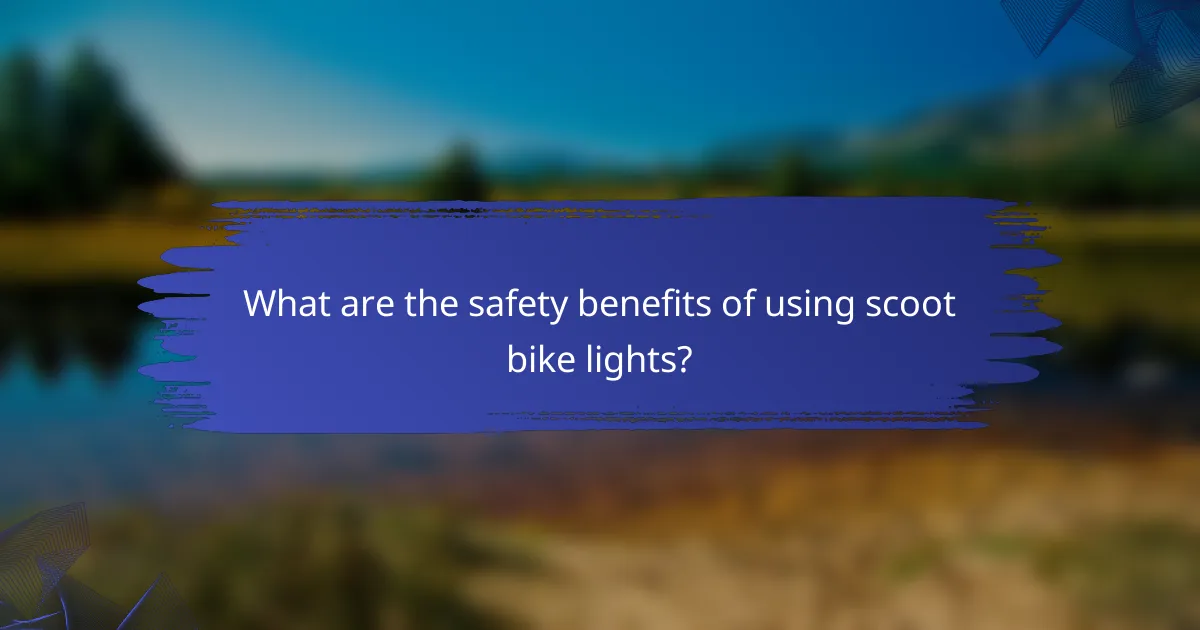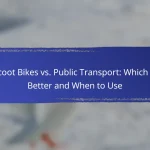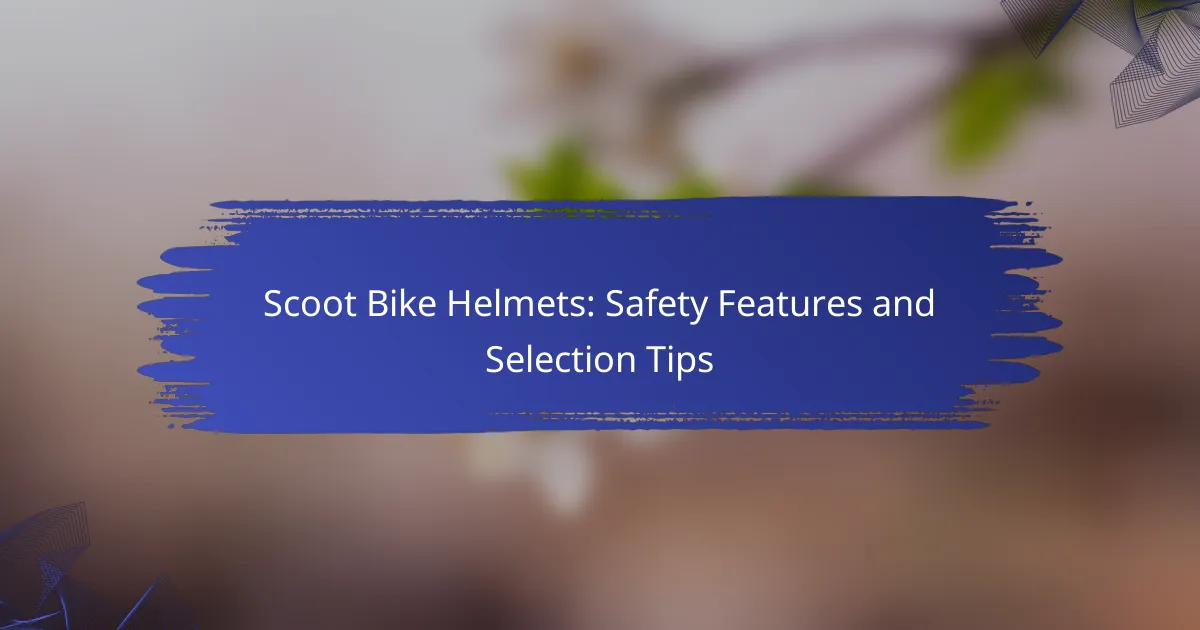When choosing scoot bike lights, brightness is a key factor, with high lumen output ensuring visibility in low-light conditions. Battery life typically ranges from 10 to 20 hours, influenced by brightness settings and battery capacity. Additionally, various mounting options, such as handlebars or helmets, provide flexibility in achieving optimal visibility and convenience while riding.

What are the best scoot bike lights for brightness?
The best scoot bike lights for brightness typically offer high lumen output, ensuring visibility in various conditions. Look for lights that provide at least several hundred lumens for effective illumination during night rides or low-light situations.
Brightest options: Cygolite Expilion 850
The Cygolite Expilion 850 is one of the brightest options available, delivering up to 850 lumens. This light features multiple brightness settings, allowing users to adjust the output based on their needs, whether for city commuting or off-road adventures.
With a robust battery life, the Expilion 850 can run for several hours on lower settings, making it practical for longer rides. Its compact design and easy mounting system ensure that it fits securely on most handlebars.
Affordable choice: Knog Blinder Road 400
The Knog Blinder Road 400 offers a great balance of brightness and affordability, providing up to 400 lumens. This light is ideal for urban cyclists who need sufficient visibility without breaking the bank.
It features a simple mounting system that allows for quick attachment and removal, making it convenient for daily use. The Blinder Road 400 also boasts a decent battery life, lasting several hours on a single charge, which is suitable for most commuting needs.

How long do scoot bike lights last on battery?
Scoot bike lights typically last between 10 to 20 hours on a single charge, depending on the model and settings used. Factors such as brightness level and battery capacity significantly influence this duration.
Average battery life: 10-20 hours
The average battery life of scoot bike lights ranges from 10 to 20 hours. Lights set to lower brightness levels generally extend battery life, while higher settings can reduce it significantly. For instance, using a flashing mode may conserve battery compared to a steady beam.
When choosing a light, consider how often you ride at night and the typical duration of your rides. If you frequently ride for extended periods, opting for lights with longer battery life is advisable.
Best long-lasting option: Lezyne Super Drive 1500XXL
The Lezyne Super Drive 1500XXL is a top choice for those seeking long-lasting performance, boasting a battery life of up to 148 hours on the lowest setting. This model combines high brightness with efficient power management, making it ideal for various riding conditions.
Additionally, the Super Drive 1500XXL features a robust build and multiple brightness modes, allowing users to customize their lighting experience. Investing in this light can be particularly beneficial for regular night riders or those navigating poorly lit areas.

What are the mounting options for scoot bike lights?
Scoot bike lights can be mounted in various ways, primarily on the handlebars or helmets. Each mounting option has its advantages and considerations that affect visibility and convenience while riding.
Handlebar mounts
Handlebar mounts are among the most common options for scoot bike lights. They typically attach directly to the handlebars using straps or brackets, allowing for easy installation and removal.
When choosing a handlebar mount, consider the diameter of your handlebars, as some mounts are adjustable while others are not. Ensure the light is securely fastened to avoid it shifting during rides, which could reduce visibility.
Helmet mounts
Helmet mounts provide a unique advantage by positioning the light at head level, which helps illuminate the path more effectively. These mounts can be attached using adhesive pads or clips, depending on the helmet design.
While helmet mounts enhance visibility, they may add weight to the helmet and can be less stable than handlebar mounts. It’s essential to ensure that the mount does not obstruct your vision or cause discomfort while riding.

How to choose the right scoot bike light?
Choosing the right scoot bike light involves assessing your specific needs for brightness, battery life, and mounting options. Understanding these factors will help you select a light that enhances your safety and visibility while riding.
Consider brightness requirements
Brightness is crucial for visibility, especially in low-light conditions. Look for lights that offer a range of lumens; typically, 100 to 300 lumens is adequate for urban riding, while off-road or rural areas may require 400 lumens or more.
When selecting a light, consider the beam pattern as well. A wider beam can illuminate the sides of the road, while a focused beam helps you see further ahead. Some lights also offer adjustable brightness settings, allowing you to conserve battery life when full brightness isn’t necessary.
Evaluate battery life needs
Battery life is essential for ensuring your scoot bike light lasts through your rides. Most lights offer battery life ranging from a few hours to over 20 hours, depending on the brightness setting. If you frequently ride longer distances, choose a light with a longer battery life or one that allows for easy recharging.
Consider the type of battery as well. Rechargeable lithium-ion batteries are common and convenient, while some lights use replaceable batteries. Always check the charging time and whether the light has a battery indicator to avoid unexpected outages during rides.

What are the safety benefits of using scoot bike lights?
Scoot bike lights significantly enhance safety by improving visibility for both the rider and other road users. They help prevent accidents, especially in low-light conditions, by making the bike more noticeable to drivers and pedestrians.
Increased visibility at night
Using scoot bike lights at night is crucial for ensuring that cyclists are seen by others on the road. Bright front and rear lights can illuminate the path ahead and signal the bike’s presence to approaching vehicles. A well-lit bike can reduce the likelihood of collisions, especially in poorly lit areas.
When choosing bike lights, consider brightness levels measured in lumens. For night riding, a front light with at least 200 lumens is recommended, while a rear light should have a minimum of 50 lumens for optimal visibility.
Enhanced safety in urban areas
In urban environments, the presence of scoot bike lights is essential for navigating through traffic and crowded streets. They help cyclists stand out amidst the hustle and bustle, making it easier for drivers to spot them. This is particularly important during dawn, dusk, or inclement weather when visibility is compromised.
Additionally, many cities have regulations that require cyclists to use lights after dark. Familiarizing yourself with local laws can help avoid fines and ensure compliance while enhancing your safety on the road.

How do weather conditions affect scoot bike light performance?
Weather conditions can significantly impact the performance of scoot bike lights, particularly in terms of visibility and battery efficiency. Rain, snow, and extreme temperatures can reduce light output and drain batteries faster, making it crucial for riders to choose lights suited for varying conditions.
Water-resistant ratings
Water-resistant ratings indicate how well a scoot bike light can withstand moisture. These ratings are often classified using the Ingress Protection (IP) system, with higher numbers signifying better protection against water. For example, an IP65 rating means the light is dust-tight and can withstand low-pressure water jets, making it suitable for rainy conditions.
When selecting a light, look for at least an IPX4 rating for basic water resistance. This ensures the light can handle splashes from any direction. For more extreme weather, consider lights with IP67 or higher, which can endure temporary submersion.
Impact of cold temperatures on battery life
Cold temperatures can negatively affect the battery life of scoot bike lights, particularly those using lithium-ion batteries. At low temperatures, chemical reactions within the battery slow down, leading to reduced capacity and shorter run times. This can mean that a light that typically lasts several hours may only function for a fraction of that time in freezing conditions.
To mitigate this issue, store your lights in a warmer place when not in use and consider using lights with temperature-resistant batteries. If riding in cold weather, check the battery level frequently and carry a backup light to ensure safety.

What are the emerging trends in scoot bike lighting technology?
Emerging trends in scoot bike lighting technology focus on enhanced visibility, energy efficiency, and smart integration. Innovations include adaptive lighting systems that adjust brightness based on surroundings and the incorporation of connectivity features for improved safety and user experience.
Smart lighting systems
Smart lighting systems utilize sensors and connectivity to optimize brightness and functionality. These systems can automatically adjust their intensity based on ambient light conditions, ensuring maximum visibility without draining the battery unnecessarily.
For instance, some smart lights can sync with a smartphone app, allowing users to customize settings or receive alerts about battery life and maintenance. This integration not only enhances safety but also provides a more personalized riding experience.
When considering smart lighting options, look for features such as automatic on/off capabilities, brightness adjustment, and compatibility with other smart devices. Avoid models that lack user-friendly interfaces or require complex setups, as simplicity can significantly enhance usability on the go.








